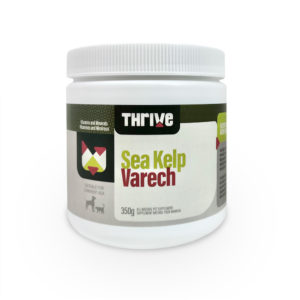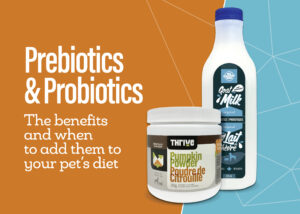
By Julie Lauzon, agr, MSc, Pet Nutrition
The Best Recipes are Always Improving
You might have noticed that over the past couple of years, balancing a raw diet has been much more involved than simply following ratio guidelines of meat, bones, organs, and vegetables. Although nutrition for our pets shouldn’t be more complicated than it is to feed ourselves and our family, the more we know about pet nutrition the more precise we can become in achieving their nutrient requirements. We will always try our best to produce the best raw pet food on the market, and will not hesitate to improve our recipes when new scientific information is available.
Recipe Formulation
With formulation software, for any animal species (humans included), the company inputs the ingredients they have access to and the software provides the cheapest recipe possible with the available ingredients that will cover the nutrient needs. If 8 years of formulating diets has taught me something, it is never to let the software do your job. Yes, on paper everything can be balanced, the nutrients will be covered, but the software only knows about nutrient analysis and price – it doesn’t know about food palatability, ingredient quality or dog and cat physiology of nutrition. In the case of the software, if a vegetable is cheaper than meat, it will give the minimum meat to cover the protein requirement and fill the rest with the cheaper vegetables. This also applies to vitamins and minerals. The software doesn’t care if heart is a rich source of B vitamins, if heart is expensive and a thiamine supplement is cheaper, then the supplement will make it into the recipe. This is how most kibbles are formulated, and how some raw brands that outsource formulation to a third party work as well.
Fruits and Veggies
When formulating diets for Big Country Raw, I always try to get the majority of nutrients from whole foods first: variety of organs, heart, high quality meat cuts. Then, if some nutrients are not found in high-quality human grade animal ingredients, I look into the addition of fruits and vegetables (for dogs). Every ingredient in our recipe has a purpose, nothing is there for “extra fiber or energy” – which is a fancy way of saying filler. Dogs don’t need a lot of fiber – 1 % is more than enough to be beneficial for the microbiome, (even if technically dogs and cats have no minimum requirement for carbs in their diet) which can be found in a small vegetable amount. Protein and fat are much more efficient sources of energy for our pets. Dogs are opportunistic carnivores and cats are strict carnivores – they do not need plant carbs to fill their energy requirements. Carbs should always be as minimal as possible (for dogs), and glycemic index (ingredients that raise blood sugar easily) should be considered. Did you know that animal meat brings carbs? Dogs and cats get plenty of carbs through the glycogen reserve of their prey – even more when fed high quality meat and organs.
When Whole Food Isn’t Enough
Sometimes, for specific nutrients, the whole food option is not the best choice. This is specifically in instances where the ingredient is impossible to get human-grade, or the amount needed is way too high to cover minimum requirements and keep the food appealing to dogs and cats.
Let’s use manganese as an example. Manganese is a micronutrient that is often missing in common 80/10/10 raw diets. Manganese is needed in a very small amount, and a manganese deficiency can take months or years to show – this will not create major health issues but won’t provide optimal health in the long term. Some natural whole food sources of manganese are: animal viscera, tripe, and some sea food like blue mussels. Manganese is a mineral that can be provided by a herbivore’s gut bacteria. As an example, a diet including 25% beef tripe would provide enough manganese. But 25% beef tripe is a lot of tripe, and some dogs simply do not like the smell (the same applies to blue mussels). Adding 25% beef tripe or blue mussels to all BCR Dinner recipes would drastically change the taste your dog loves so much. Another option would be to pair a vegetable source with a high-quality chelated supplement – that way we keep the great taste and digestibility, while we control the amount of manganese.
Another example would be the inclusion of ingredients such as brain, eyes, and thyroid tissues to cover zinc, DHA and iodine. A carnivore in the wild will eat these organs and tissues, but when strictly using human-grade, CFIA inspected and approved suppliers, we don’t have access to those animal parts.
This is How Big Country Raw Diets are Formulated
1. Establish what guidelines to follow. We decided to follow NRC guidelines as it applies better to a raw diet, while AAFCO uses a much lower digestibility factor, associated with high cooking temperature and high carbs inclusion. Following AAFCO for raw can imply a higher quantity of salt and heavy metals in the diet which can be harmful in the long run.
2. Using food analysis software formulation, and dog and cat physiology of nutrition to achieve as much of the minimum nutrient requirement as possible with whole foods, while keeping in mind the essential role of each micronutrient, as well as the proven Big Country Raw recipe palatability.
3. Cover the remaining small gaps in the formulation with carefully chosen high quality vegetables and chelated minerals.
At Big Country Raw, we have nothing to hide, we do not use any filler and we strongly believe in the high quality of our recipe formulation.
Below we have outlined the purpose of each ingredient found in our Big Country Raw Dinner formulas:
High Quality Lean Meat Cut; Meat is always the main portion of Big Country Raw recipes. Meat is a great source of many nutrients, like all of the essential amino acids and fatty acids, as well as magnesium, B vitamins, vitamin D, potassium, magnesium, selenium, zinc and sodium. Each animal meat is unique in its nutrient profile, and providing a rotational diet is very beneficial.
Heart; This muscle meat is the perfect in-between of meat and organs, and is a high quality source of some micro nutrients like B vitamins, Vitamin D, Iron, sodium, potassium and Selenium. Including a significant amount of high-quality muscle meat including heart, will cover many vitamins and minerals that are commonly added in “cheaper” recipes.
Bones; An extraordinary source of macro nutrients Calcium and Phosphorus, as well as other minerals – but not all bones are equal. Instead of using poultry bones in all the recipes, Big Country Raw adds a little more calcium and phosphorus to the beef, lamb, pork and fish recipe to support the minerals that low density bones bring in those specific protein choices.
Secreting Organs; Liver and spleen are the main organs used in our recipes, along with kidney. Liver and spleen are incredibly dense in Iron, vitamins (A, B, D), Zinc, and Copper. Including other organs outside of just liver is also a way to cover micronutrients without having to add them with supplements. That being said, not all organs are equal, and this is why beef organs are used in most of our recipes, as they are highly nutritious compared to poultry organs.
Spinach, Broccoli, Green Beans, Blueberries, and Cranberries; All very well-known super foods for dogs. Together, they are a wonderful source of vitamin K and C, as well as potassium, magnesium, iron, zinc, manganese, and B vitamins. Other than contributing to the vitamins and minerals, these bring exceptional phytonutrients that are known for their anti-cancer, anti-inflammatory and antioxidant properties.
- Broccoli is one of the few food sources of Sulforaphane and DIM, two well-documented cancer and inflammatory fighting molecules.
- Blueberries’ unique blue/red pigment, also called anthocyanin, is also very well known for its incredible antioxidant properties which fight against cell damage and aging.
- Spinach is another well-known anti-cancer food, high in flavonoid and antioxidants (like kaempferol), as well as an incredible source of folate (B vitamin).
- Cranberries are well known for their incredibly beneficial impact on oral health and urinary tract support.
- Green beans are very rich in soluble and insoluble fiber, while keeping an extremely low glycemic index, a perfect prebiotic for your dog’s microbiome.
Speaking of glycemic index, all Big Country Raw fruits and vegetables have a glycemic index lower then 30, making our Dinner Recipes a good option for dogs as a preventative of diabetes, or for dogs dealing with diabetes or any other sugar related issues like yeast infections. For example, the glycemic index of pumpkin and squash are twice as high (over 65), and potatoes (or similar vegetables like yams and yucca) are extremely high (over 80).
Sea Kelp; One of the most common missing nutrients in a raw diet using strictly human grade food is Iodine. It is an essential nutrient for the thyroid gland function, and sea kelp is a highly bioavailable source of Iodine for pets and will also bring other nutrients like sodium and Iron.
Wheat Grass and Barley Grass: Freshly harvested sprouts (without the seed) of these two plants are an incredible source of highly digestible micronutrients and phytonutrients (like glutathione and Vitamin E antioxidant) and can also be used as a superfood for dogs and cats. Together, they bring an appreciable amount of Zinc, Vitamin E, C and K, as well as B vitamins.
Chelated Minerals; After using all the incredible ingredients mentioned above, Big Country Raw, in order to provide the most stable and digestible raw food possible, covered some minor nutrient gaps with extra Zinc, Copper and Manganese chelated minerals. The minerals are bounded to complex peptides, making them as (or more) digestible as the natural whole food form.
Vitamin E; Even if some of our ingredients are a great source of Vitamin E, we added a little bit of natural plant-based oil extract of Vitamin E for all its incredible antioxidant properties. Since we always recommend including fresh whole fish or fish oil, extra Vitamin E can only be beneficial to keep all the good advantages of those polyunsaturated fatty acids.
Wondering why there is no fish oil in our recipes? Don’t miss our upcoming blog post: Fish Oil – A Sensitive Superfood
We’ve always been transparent with our customers because we are proud of the food we make, and we stand behind every ingredient we add in our recipes. I hope you have enjoyed reading about the secrets behind Big Country Raw’s formulation and that you feel confident that you are offering your pet the best raw food on the market.
Magasinez maintenant





